Starting Modes of Bi-Directional Plasma Thruster Utilizing Krypton
Abstract
:1. Introduction
2. Bi-Directional Plasma Thruster
3. Testing Facility and Methodology
3.1. Test Bench
3.2. RF Equipment and RF Connection Lines
3.3. Gas Feedthrough Features
3.4. Methodology
4. Results and Discussion
4.1. General Analysis
4.2. Contradictions to Previous Studies on Magnetized RF Breakdown
4.3. Classical Diffusion Theory
4.4. Pondermotive Effect
4.5. Active Electron Source
5. Conclusions
Author Contributions
Funding
Data Availability Statement
Conflicts of Interest
References
- Feuerborn, S.A.; Perkins, J.; Neary, D.A. Finding a way: Boeing’s all electric propulsion satellite. In Proceedings of the 49th AIAA/ASME/SAE/ASEE Joint Propulsion Conference, San Jose, CA, USA, 13–17 July 2013. [Google Scholar] [CrossRef]
- Shumeiko, A.I.; Jarrar, F.S.; Swei, S.S. Advanced wave plasma thruster with multiple thrust vectoring capability. In Proceedings of the AIAA SCITECH 2022 Forum, San Diego, CA, USA, 3–7 January 2022. [Google Scholar] [CrossRef]
- Shumeiko, A.I.; Telekh, V.D.; Mayorova, V.I. Development of a novel wave plasma propulsion module with six-directional thrust vectoring capability. Acta Astronaut. 2022, 191, 431–437. [Google Scholar] [CrossRef]
- Takahashi, K. Thirty percent conversion efficiency from radiofrequency power to thrust energy in a magnetic nozzle plasma thruster. Sci. Rep. 2022, 12, 18618. [Google Scholar] [CrossRef] [PubMed]
- Takahashi, K.; Charles, C.; Boswell, R.W.; Ando, A. Demonstrating a new technology for space debris removal using a bi-directional plasma thruster. Sci. Rep. 2018, 8, 14417. [Google Scholar] [CrossRef] [PubMed]
- Romano, F.; Chan, Y.A.; Herdrich, G.; Traub, C.; Fasoulas, S.; Roberts, P.C.E.; Smith, K.; Edmondson, S.; Haigh, S.; Crisp, N.H.; et al. RF helicon-based inductive plasma thruster (IPT) design for an atmosphere-breathing electric propulsion system (ABEP). Acta Astronaut. 2020, 176, 476–483. [Google Scholar] [CrossRef]
- Shumeiko, A.I.; Telekh, V.D.; Mayorova, V.I. Development of a six-directional plasma propulsion module for small satellites. In Proceedings of the 71st International Astronautical Congress, Virtual, 12–14 October 2020. [Google Scholar]
- Sekine, H.; Koizumi, H.; Komurasaki, K. Electrostatic ion acceleration in an inductive radio-frequency plasma thruster. Phys. Plasmas 2020, 27, 103513. [Google Scholar] [CrossRef]
- Shumeiko, A.I.; Jarrar, F.S.; Swei, S.S. Development of novel electrodeless plasma thruster with multiple thrust vectoring capability. In Proceedings of the 72nd International Astronautical Congress, Dubai, United Arab Emirates, 25–29 October 2021. [Google Scholar]
- Shumeiko, A.I. Nature-Inspired Concepts for High-Power Electric Propulsion Systems. Fusion Sci. Technol. 2023. [Google Scholar] [CrossRef]
- Shinohara, S. Development of featured high-density helicon sources and their application to electrodeless plasma thruster. Plasma Phys. Control. Fusion 2018, 61, 014017. [Google Scholar] [CrossRef]
- Feldman, M.; Choueiri, E. Direct wave-drive thruster. J. Propuls. Power 2018, 34, 1124–1130. [Google Scholar] [CrossRef]
- Razin, Y. A direct fusion drive for rocket propulsion. Acta Astronaut. 2014, 105, 145–155. [Google Scholar] [CrossRef]
- Arefiev, A.; Breizman, B. Theoretical components of the VASIMR plasma propulsion concept. Phys. Plasmas 2004, 11, 2942–2949. [Google Scholar] [CrossRef]
- Takahashi, K. Comparison of vacuum-immersed helicon thrusters terminated by upstream magnetic and physical walls. J. Phys. D Appl. Phys. 2023, 56, 475207. [Google Scholar] [CrossRef]
- Shumeiko, A.I.; Telekh, V.D. Helicon engine in outboard air as a successful solution for maintaining small space vehicle in orbits up to 200 km. AIP Adv. 2023, 2171, 170019. [Google Scholar] [CrossRef]
- Ryzhkov, S.V. Magneto-Inertial Fusion and Powerful Plasma Installations (A Review). Appl. Sci. 2023, 13, 6658. [Google Scholar] [CrossRef]
- Kuzenov, V.V.; Ryzhkov, S.V.; Varaksin, A.Y. Simulation of Parameters of Plasma Dynamics of a Magneto Plasma Compressor. Appl. Sci. 2023, 13, 5538. [Google Scholar] [CrossRef]
- Kuzenov, V.V.; Ryzhkov, S.V.; Frolko, P.A. Numerical simulation of the coaxial magneto-plasma accelerator and non-axisymmetric radio frequency discharge. J. Phys. Conf. Ser. 2017, 830, 012049. [Google Scholar] [CrossRef]
- Kuzenov, V.V.; Seleznev, R.K.; Ryzhkov, S.V. Development of helicon plasma thruster model. In Proceedings of the 53rd AIAA/SAE/ASEE Joint Propulsion Conference, Atlanta, GA, USA, 10–12 July 2017. [Google Scholar] [CrossRef]
- Stark, W.; Gondol, N.; Tajmar, M. Concept and design of a hall-effect thruster with integrated thrust vector control. J. Electr. Propuls. 2022, 1, 21. [Google Scholar] [CrossRef]
- Buldrini, N.; Seifert, B.; Reissner, A. Ion Thruster for Thrust Vectored Propulsion of a Spacecraft. U.S. Patent Application No. 2021/0300599A1, 2 August 2018. [Google Scholar]
- Imai, R.; Takahashi, K. Demonstrating a magnetic steering of the thrust imparted by the magnetic nozzle radiofrequency plasma thruster. Appl. Phys. Lett. 2021, 118, 264102. [Google Scholar] [CrossRef]
- Takahashi, K.; Imai, R. Two-dimensional deflection of a plasma plume exhausted from a magnetically steered radiofrequency plasma thruster. Phys. Plasmas 2022, 29, 054501. [Google Scholar] [CrossRef]
- Shumeiko, A.I.; Telekh, V.D.; Ryzhkov, S.V. Probe diagnostics and optical emission spectroscopy of wave plasma source exhaust. Symmetry 2022, 14, 1983. [Google Scholar] [CrossRef]
- Thakur, S.C.; Brandt, C.; Cui, L.; Gosselin, J.J.; Tynan, G.R. Formation of the blue core in argon helicon plasma. IEEE Trans. Plasma Sci. 2015, 43, 2754–2759. [Google Scholar] [CrossRef]
- Shamrai, K.P. Stable modes and abrupt density jumps in a helicon plasma source. Plasma Sources Sci. Technol. 1998, 7, 499. [Google Scholar] [CrossRef]
- Chen, F.F. Helicon discharges and sources: A review. Plasma Sources Sci. Technol. 2015, 24, 014001. [Google Scholar] [CrossRef]
- Jiménez, P.; Merino, M.; Ahedo, E. Wave propagation and absorption in a helicon plasma thruster and its plume. Plasma Sources Sci. Technol. 2022, 31, 045009. [Google Scholar] [CrossRef]
- Kihara, T. The mathematical theory of electrical discharges in gases. Rev. Mod. Phys. 1952, 24, 45. [Google Scholar] [CrossRef]
- Lisovsky, V.A.; Yegorenkov, V.D. Low-pressure gas breakdown in combined fields. J. Phys. D Appl. Phys. 1994, 27, 2340. [Google Scholar] [CrossRef]
- Smith, H.B.; Charles, C.; Boswell, R.W. Breakdown behavior in radio-frequency argon discharges. Phys. Plasmas 2003, 10, 875–881. [Google Scholar] [CrossRef]
- Radmilović-Radjenović, M.; Radjenović, B. The effect of magnetic field on the electrical breakdown characteristics. J. Phys. D Appl. Phys. 2006, 39, 3002. [Google Scholar] [CrossRef]
- Radmilovic-Radjenovic, M.; Radjnovic, B. The influence of the magnetic field on the electrical breakdown phenomena. Plasma Sci. Technol. 2007, 9, 45. [Google Scholar] [CrossRef]
- Wiebold, M.; Ren, H.; Denning, C.M.; Scharer, J.E. Low-pressure helicon-plasma discharge initiation via magnetic field ramping. IEEE Trans. Plasma Sci. 2009, 37, 2110–2115. [Google Scholar] [CrossRef]
- Kumar, S.; Chandra, A.; John, P.I.; Sarkar, D.C. Study of rf breakdown characteristics in the presence of parallel electric and magnetic fields. J. Phys. D Appl. Phys. 1971, 4, 959. [Google Scholar] [CrossRef]
- Scheubert, P.; Fantz, U.; Awakowicz, P.; Paulin, H. Experimental and theoretical characterization of an inductively coupled plasma source. J. Appl. Phys. 2001, 90, 587–598. [Google Scholar] [CrossRef]
- Takahashi, K. Radiofrequency antenna for suppression of parasitic discharges in a helicon plasma thruster experiment. Rev. Sci. Instrum. 2012, 83, 083508. [Google Scholar] [CrossRef] [PubMed]
- Takahashi, K.; Takao, Y.; Ando, A. Low-magnetic-field enhancement of thrust imparted by a stepped-diameter and downstream-gas-injected rf plasma thruster. Plasma Sources Sci. Technol. 2019, 28, 085014. [Google Scholar] [CrossRef]
- Chen, F.F. Introduction to Plasma Physics; Springer Science & Business Media: Berlin/Heidelberg, Germany, 2012. [Google Scholar]
- Maiorov, S.A.; Kodanova, S.K.; Bastykova, N.K.; Golyatina, R.I.; Ramazanov, T.S.; Omiraliyeva, G.K. The effect of magnetic field on diffusion and drift of electrons in helium and xenon. Phys. Plasmas 2022, 29, 043502. [Google Scholar] [CrossRef]
- Godyak, V. Hot plasma effects in gas discharge plasma. Phys. Plasmas 2005, 12, 055501. [Google Scholar] [CrossRef]
- Smolyakov, A.I.; Godyak, V.; Tyshetskiy, Y. Effect of the electron thermal motion on the ponderomotive force in inductive plasma. Phys. Plasmas 2001, 8, 3857–3860. [Google Scholar] [CrossRef]

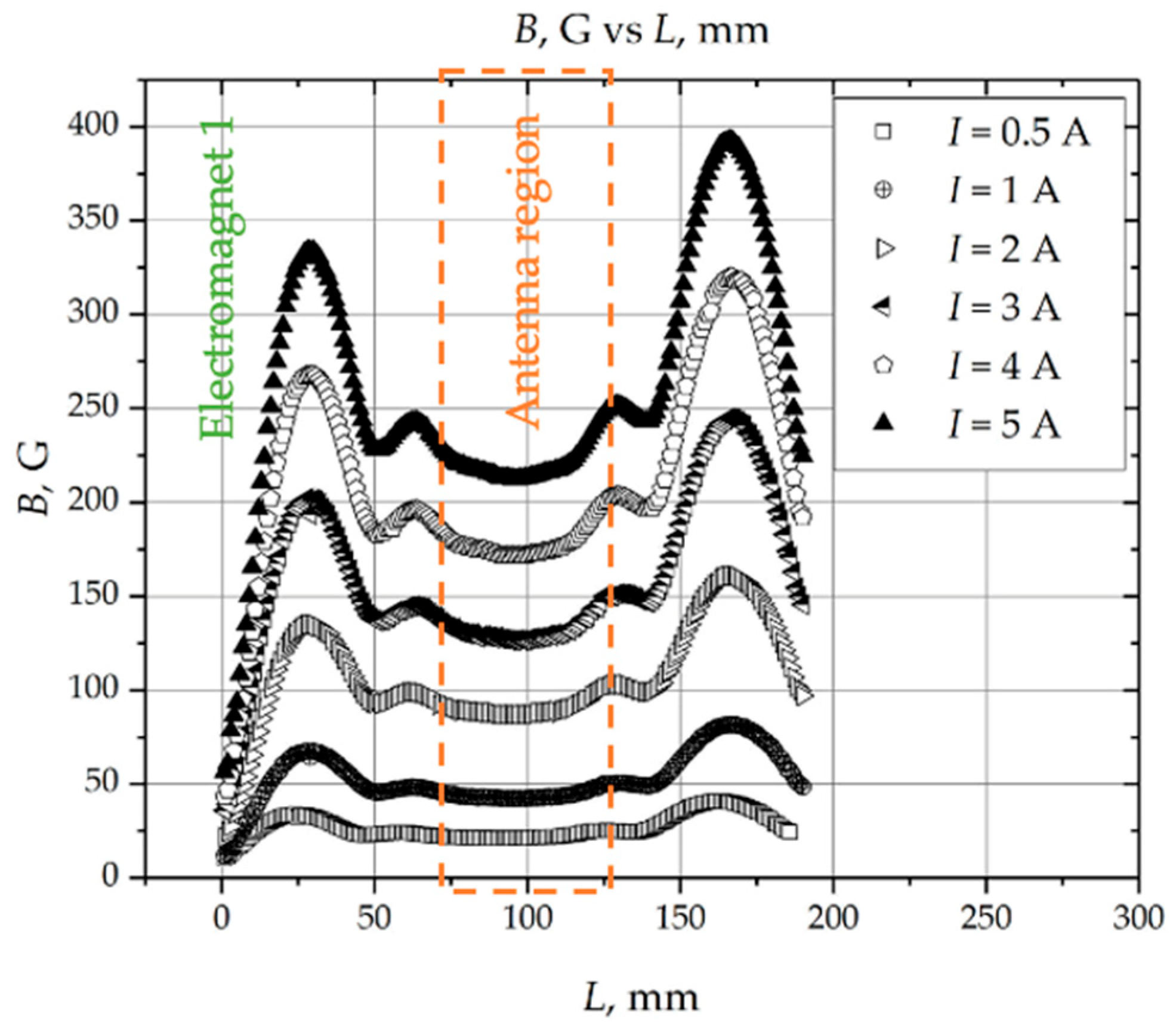
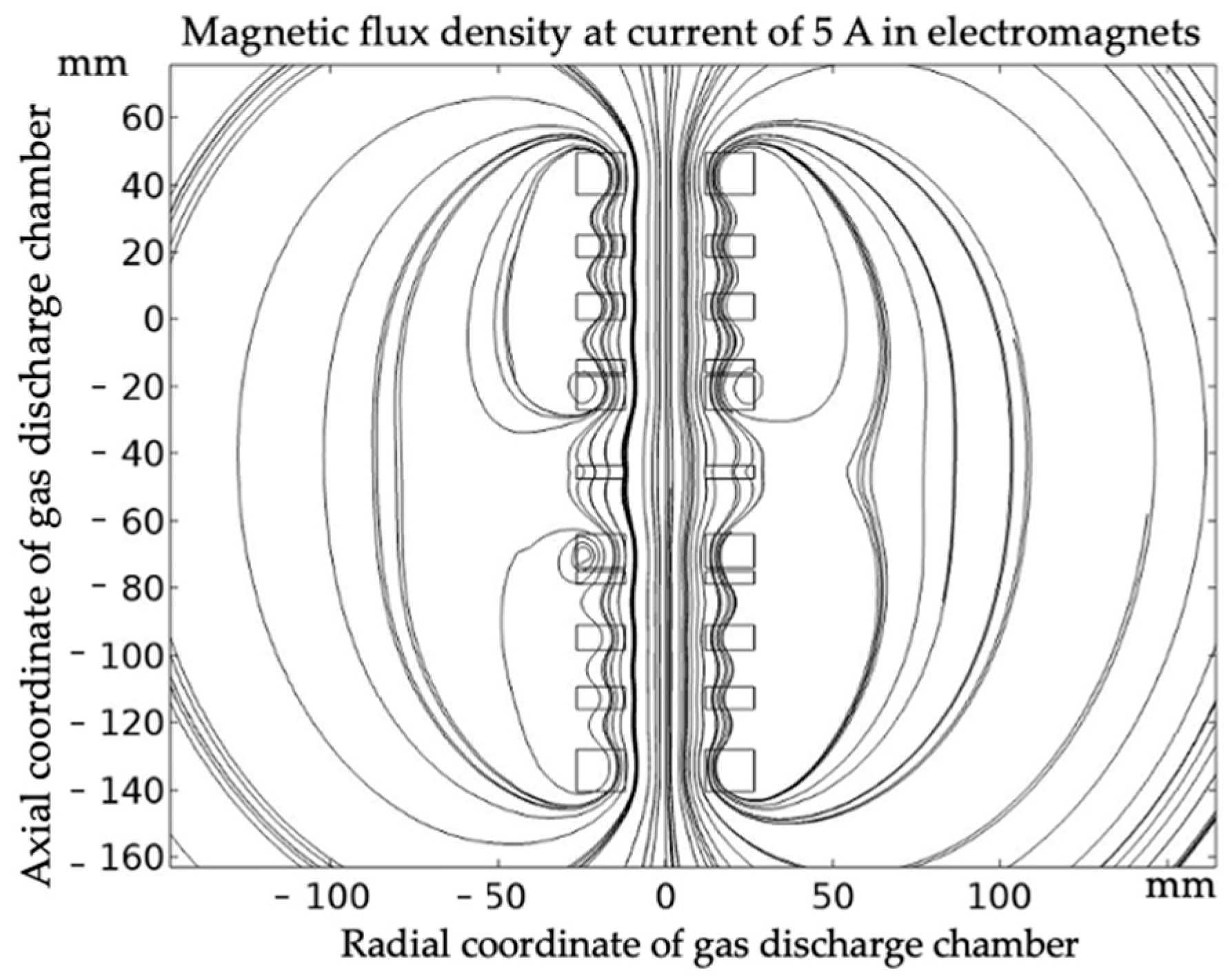

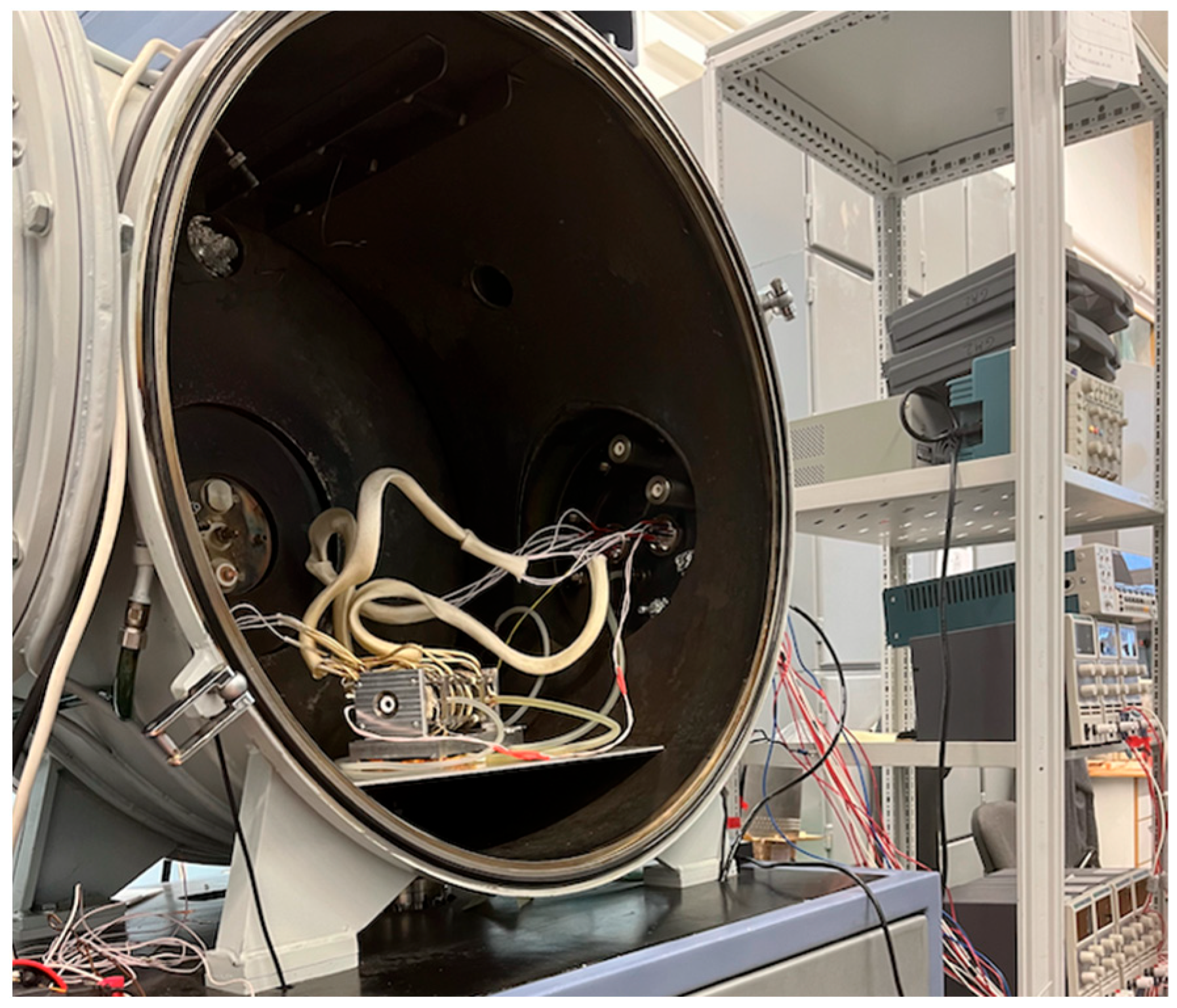



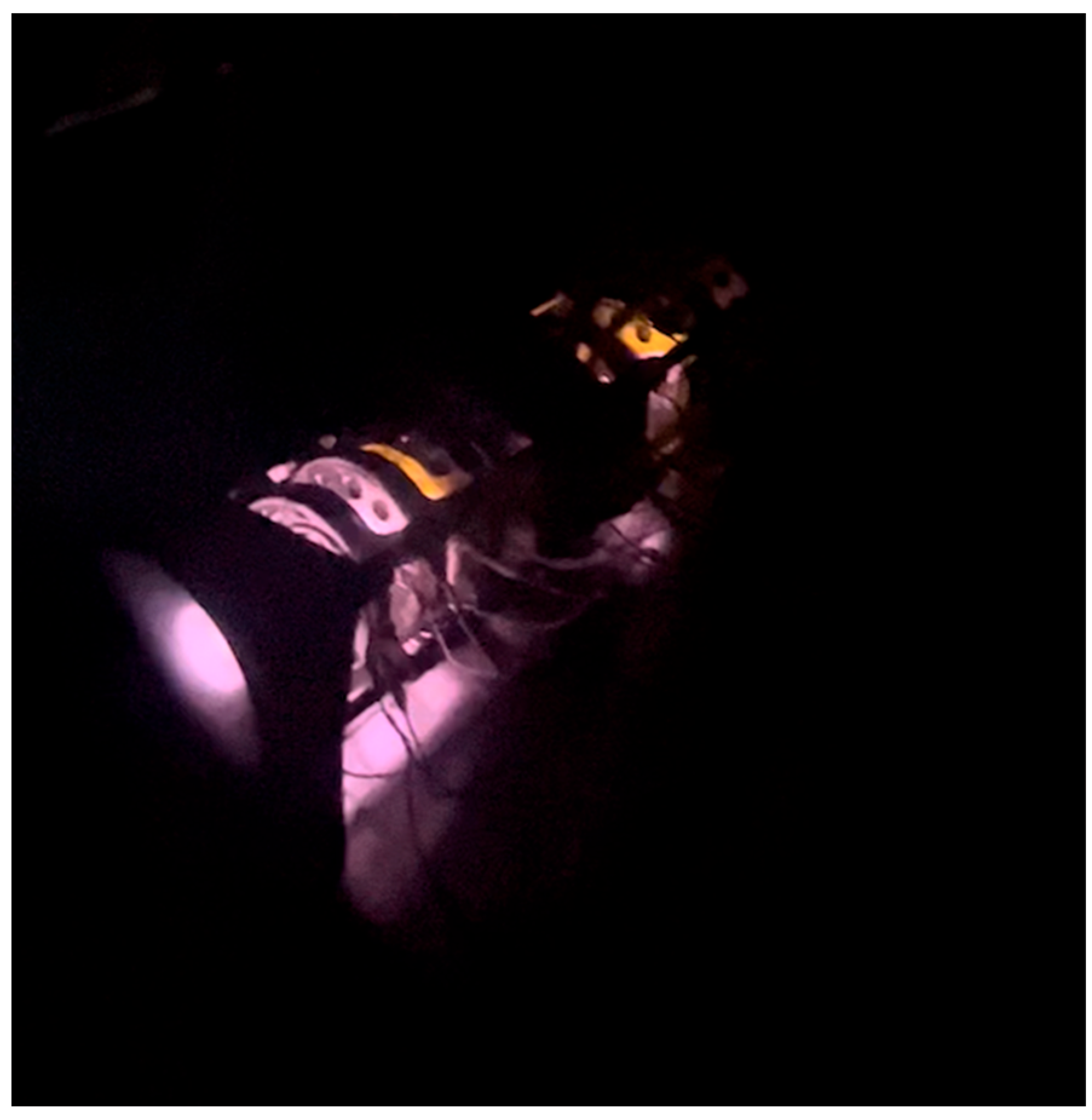
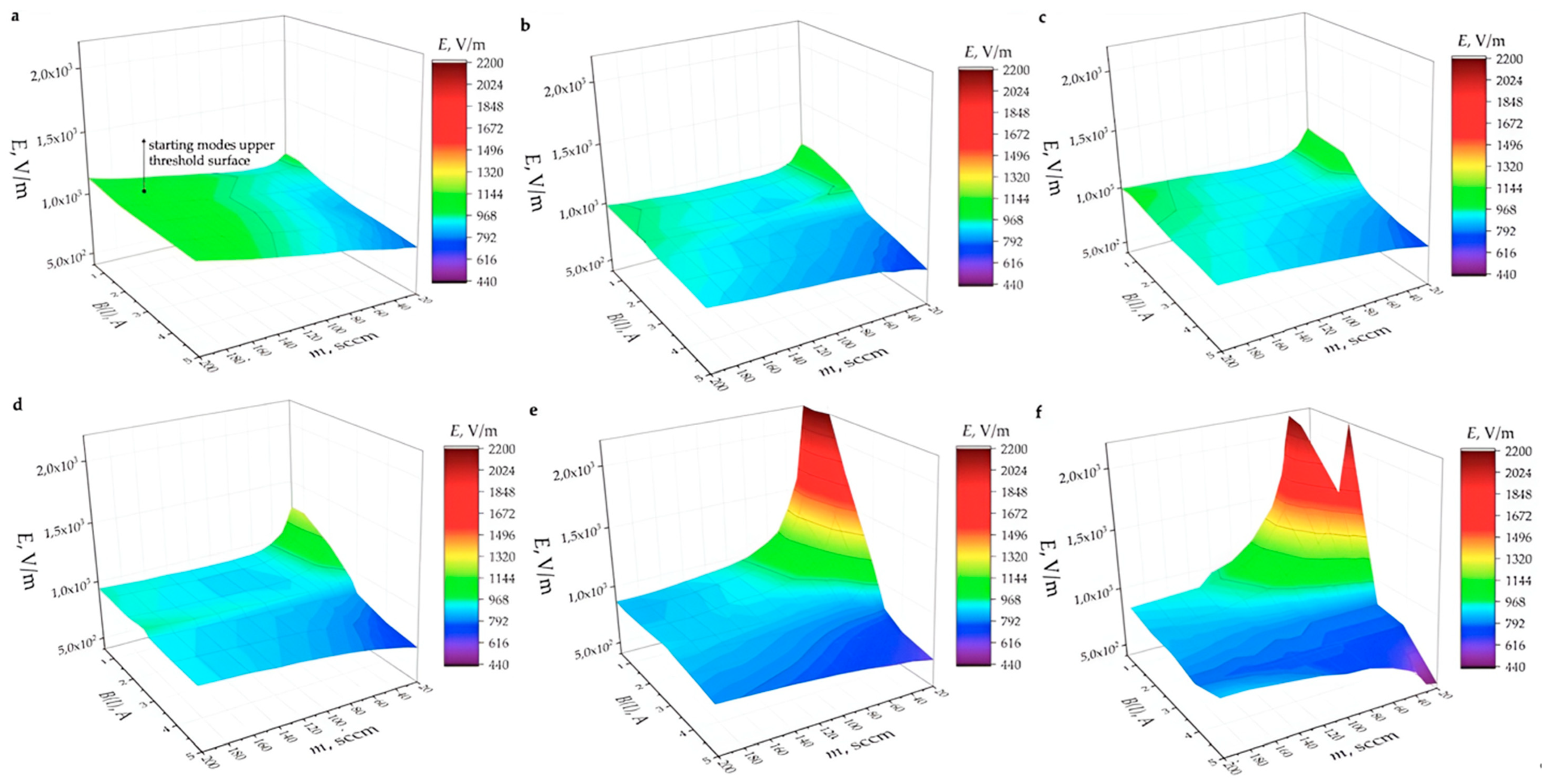

| , A | 0.5 | 1 | 2 | 3 | 4 | 5 |
|---|---|---|---|---|---|---|
| 2 to 2 × 102 | 8.4 to 8.4 × 102 | 2.7 × 101 to 2.7 × 103 | 5.3 × 101 to 5.3 × 103 | 1 × 102 to 1 × 104 | 1.7 × 102 to 1.7 × 104 | |
| , V/m | 900 to 2200 | 850 to 2200 | 800 to 790 | 750 to 650 | 650 to 490 | 600 to 440 |
Disclaimer/Publisher’s Note: The statements, opinions and data contained in all publications are solely those of the individual author(s) and contributor(s) and not of MDPI and/or the editor(s). MDPI and/or the editor(s) disclaim responsibility for any injury to people or property resulting from any ideas, methods, instructions or products referred to in the content. |
© 2023 by the authors. Licensee MDPI, Basel, Switzerland. This article is an open access article distributed under the terms and conditions of the Creative Commons Attribution (CC BY) license (https://creativecommons.org/licenses/by/4.0/).
Share and Cite
Shumeiko, A.I.; Telekh, V.D.; Ryzhkov, S.V. Starting Modes of Bi-Directional Plasma Thruster Utilizing Krypton. Symmetry 2023, 15, 1705. https://doi.org/10.3390/sym15091705
Shumeiko AI, Telekh VD, Ryzhkov SV. Starting Modes of Bi-Directional Plasma Thruster Utilizing Krypton. Symmetry. 2023; 15(9):1705. https://doi.org/10.3390/sym15091705
Chicago/Turabian StyleShumeiko, Andrei I., Victor D. Telekh, and Sergei V. Ryzhkov. 2023. "Starting Modes of Bi-Directional Plasma Thruster Utilizing Krypton" Symmetry 15, no. 9: 1705. https://doi.org/10.3390/sym15091705
APA StyleShumeiko, A. I., Telekh, V. D., & Ryzhkov, S. V. (2023). Starting Modes of Bi-Directional Plasma Thruster Utilizing Krypton. Symmetry, 15(9), 1705. https://doi.org/10.3390/sym15091705





